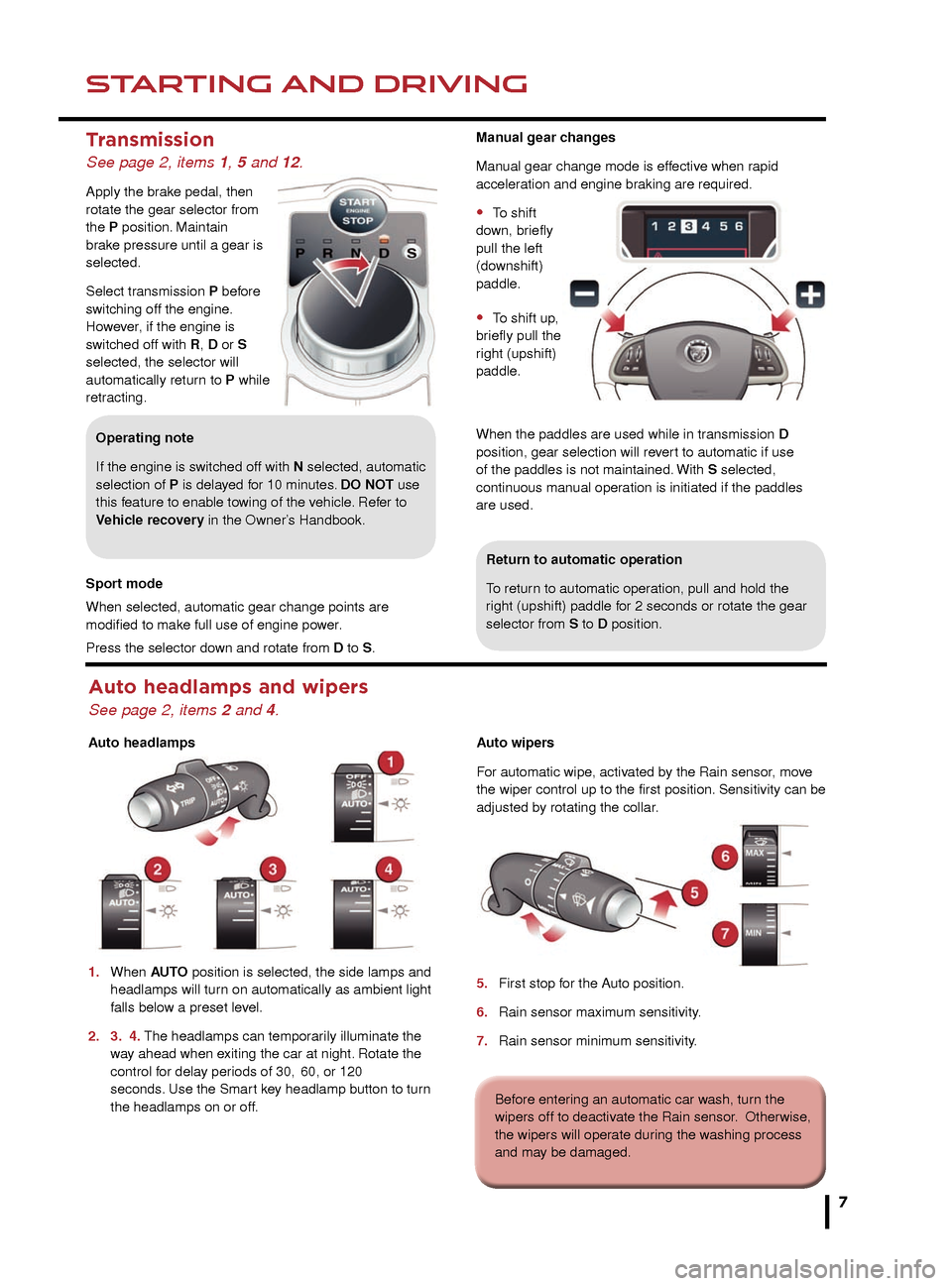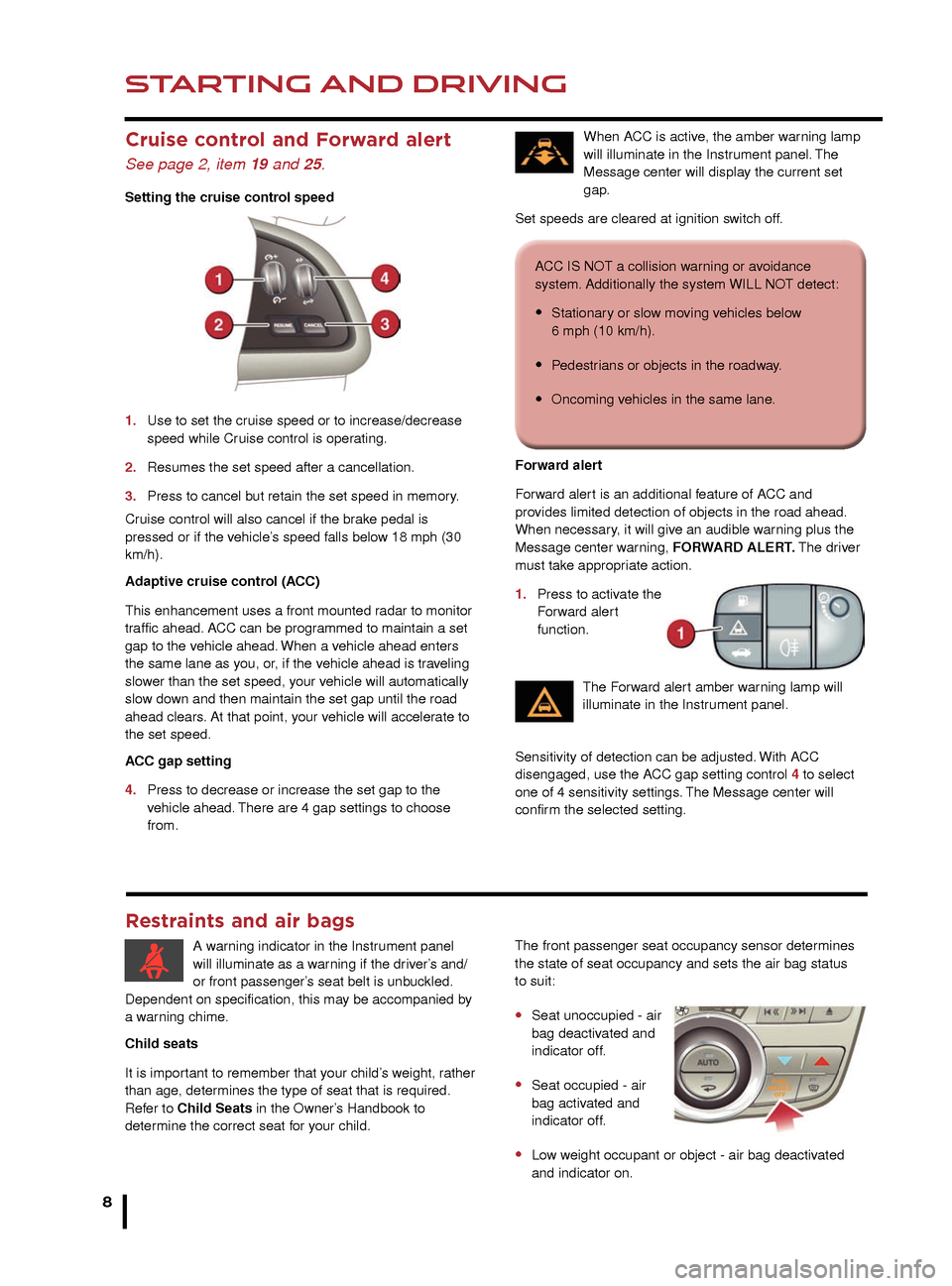brake sensor JAGUAR XK 2014 1.G Quick Start Guide
[x] Cancel search | Manufacturer: JAGUAR, Model Year: 2014, Model line: XK, Model: JAGUAR XK 2014 1.GPages: 16, PDF Size: 1.7 MB
Page 7 of 16

Transmission
See page 2, items 1, 5 and 12.
Apply the brake pedal, then
rotate the gear selector from
the P position. Maintain
brake pressure until a gear is
selected.
Select transmission P before
switching off the engine.
However, if the engine is
switched off with R, D or S
selected, the selector will
automatically return to P while
retracting.
STARTING AND DRIVINGSTARTING AND DRIVING
7
7
Return to automatic operation
To return to automatic operation, pull and hold the
right (upshift) paddle for 2 seconds or rotate the gear
selector from S to D position.
Auto headlamps and wipers
See page 2, items 2 and 4.
Auto headlamps
1.
When
AUTO position is selected, the side lamps and
headlamps will tur
n on automatically as ambient light
f
alls below a preset level.
2.
3.
4. The headlamps can temporarily illuminate the
w
ay ahead when exiting the car at night. Rotate the
control f
or delay periods of 30,
60, or 120
seconds
. Use the Smart key headlamp button to turn
the headlamps on or off
.Auto wipers
For automatic wipe, activated by the Rain sensor, move
the wiper control up to the first position. Sensitivity can be
adjusted by rotating the collar.
5.
First stop f
or the Auto position.
6.
Rain sensor maxim
um sensitivity.
7.
Rain sensor minim
um sensitivity.
Before entering an automatic car wash, turn the
wipers off to deactivate the Rain sensor. Otherwise,
the wipers will operate during the washing process
and may be damaged.
Manual gear changes
Manual gear change mode is effective when rapid
acceleration and engine braking are required.
• To shift
down, briefly
pull the left
(downshift)
paddle.
• To shift up,
briefly pull the
right (upshift)
paddle.
When the paddles are used while in transmission D
position, gear selection will revert to automatic if use
of the paddles is not maintained. With S selected,
continuous manual operation is initiated if the paddles
are used.
• The EPB is automatically released when the
transmission is moved from the P position.
Note: DO NOT use the EPB
recess as a storage area.
Rolling start
If the engine is switched off while the vehicle is moving,
it can be restarted after 2 seconds have elapsed. Select
transmission N position and then press the START/STOP
button.
Smart key use
The engine will continue to run, even if the Smart
key is removed from the vehicle. However, if the
engine is stopped, it cannot be restarted until the
Smart key is returned to the vehicle.
Air bag fault.
Rear fog lamp on.
Forward alert active.
Adaptive cruise control
active.
Operating note
If the engine is switched off with N selected, automatic
selection of P is delayed for 10 minutes. DO NOT use
this feature to enable towing of the vehicle. Refer to
Vehicle recovery in the Owner’s Handbook.
Sport mode
When selected, automatic gear change points are
modified to make full use of engine power.
Press the selector down and rotate from D to S.
Page 8 of 16

STARTING AND DRIVING
8
STARTING AND DRIVING
Rear camera and Parking aids
Rear camera
Activates when transmission R is selected. The Touch
screen will display guidance lines to aid reversing. When
a forward gear is selected and the vehicle’s speed is
greater than 10 mph (16 km/h), the Rear camera will
deactivate.
The Rear camera view has priority over the Parking aid
view. To display the Parking aid view instead, touch the
screen.
Note: Sensors may activate when water, snow, or ice is
detected on their surfaces. Make sure that the sensors
are cleaned regularly.
Parking aids
When transmission R is selected, Parking aids at the rear
and front will activate.
The Touch screen will display a representation of the
vehicle and indicate any obstruction detected. A colored
bar will show the approximate distance from the vehicle
to the obstruction.
Cruise control and Forward alert
See page 2, item 19 and 25.
Setting the cruise control speed
1.
Use to set the cr
uise speed or to increase/decrease
speed while Cr
uise control is operating.
2.
Resumes the set speed after a cancellation.
3
.
Press to cancel b
ut retain the set speed in memory.
Cruise control will also cancel if the brake pedal is
pressed or if the vehicle’s speed falls below 18 mph (30
km/h).
Adaptive cruise control (ACC)
This enhancement uses a front mounted radar to monitor
traffic ahead. ACC can be programmed to maintain a set
gap to the vehicle ahead. When a vehicle ahead enters
the same lane as you, or, if the vehicle ahead is traveling
slower than the set speed, your vehicle will automatically
slow down and then maintain the set gap until the road
ahead clears. At that point, your vehicle will accelerate to
the set speed.
ACC gap setting
4.
Press to decrease or increase the set gap to the
v
ehicle ahead. There are 4 gap settings to choose
from. When ACC is active, the amber warning lamp
will illuminate in the Instrument panel. The
Message center will display the current set
gap.
Set speeds are cleared at ignition switch off.
Forward alert
Forward alert is an additional feature of ACC and
provides limited detection of objects in the road ahead.
When necessary, it will give an audible warning plus the
Message center warning, FORWARD ALERT. The driver
must take appropriate action.
1.
Press to activ
ate the
F
orward alert
function.The Forward alert amber warning lamp will
illuminate in the Instrument panel.
Sensitivity of detection can be adjusted. With ACC
disengaged, use the ACC gap setting control 4 to select
one of 4 sensitivity settings. The Message center will
confirm the selected setting.
ACC IS NOT a collision warning or avoidance
system. Additionally the system WILL NOT detect:
• Stationary or slow moving vehicles below
6 mph (10 km/h).
• Pedestrians or objects in the roadway.
• Oncoming vehicles in the same lane.
Garage door opener
1. The buttons in the roof console can be programmed
to transmit radio frequencies that can operate
external devices, such as, garage doors,
entry gates, security systems, etc.
See the Owner’s Handbook for full operating instructions.
Restraints and air bags
A warning indicator in the Instrument panel
will illuminate as a warning if the driver’s and/
or front passenger’s seat belt is unbuckled.
Dependent on specification, this may be accompanied by
a warning chime.
Child seats
It is important to remember that your child’s weight, rather
than age, determines the type of seat that is required.
Refer to Child Seats in the Owner’s Handbook to
determine the correct seat for your child.The front passenger seat occupancy sensor determines
the state of seat occupancy and sets the air bag status
to suit:
• Seat unoccupied - air
bag deactiv ated and
indicator off
.
• Seat occupied - air
bag activ ated and
indicator off
.
• Low weight occupant or object - air bag deactivated
and indicator on.